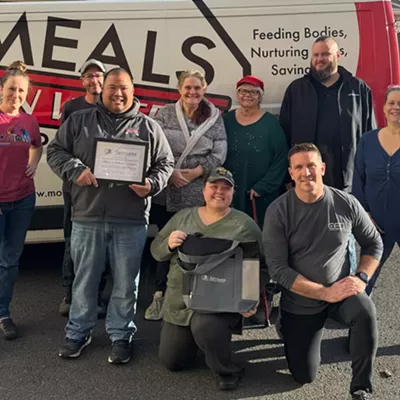It may be the hardest habit to break: Opting for “cruelty-free” animal products or smaller bunches of lettuce when the other, bigger stuff costs half as much.
Concerns about hormones and pesticide residues tend to diminish when it comes time to fork over more than $5 for a gallon of organic milk or pay twice as much for produce.
“In America, we’re used to cheap food,” says Inland Northwest food advocate Eden Brightspirit Hendrix. “And we’ve been told repeatedly that we should have access to cheap food.”
That cheap food actually comes at quite a cost, according to Steven Hopp, biologist and co-author (with wife Barbara Kingsolver) of Animal, Vegetable, Miracle.
“Consumers don’t realize how much we’re already paying … before we even get to the supermarket,” Hopp writes. By his calculations, the costs of industrial fuel use (to transport food around the country and world), Farm Bill subsidies, pesticides and other expenses add up to about $80 million, or $725 annually per household. And millions of pounds of waste are left behind by Concentrated Animal Feeding Operations (CAFOs), where most meat and eggs are produced.
But Hendrix, keenly aware of the economic and environmental impacts of big agribusiness, says this kind of information doesn’t motivate families to make different choices.
“You can’t reach people with negativity. They’ll hear the message, feel guilty and act upon it once. You have to use something positive that they can wrap themselves around and feel good about.”
A self-proclaimed “foodie” with 30 years of cultivating both community organic farms and business relationships, Hendrix’s current “something positive” is her store, Fresh Abundance. She promises “fresh-from-the-farm” fruits, vegetables, eggs and meats, as well as chemical-free household products.
Customers can shop at three Spokane locations, or have food delivered free. Hendrix says the chance for customers to learn about their growers is an added value.
Of course, relationships with growers are a major attraction of local farmers markets as well — buying locally grown food becomes much easier during the summer months. Adding to consumers’ year-round local options, the Main Market Co-op is set to open in downtown Spokane in late fall. The Market will not only offer sustainably grown local foods, but also aims to reduce the carbon-footprint of providing food. The co-op plans to offer activities and classes that reach out to the community.
Education is key, says Hendrix: “We are more responsible consumers and caretakers if we are more in touch with our food and where it comes from.”
“Mom, where do groceries come from?”
Misty Springer agrees wholeheartedly, which is just one of the reasons she likes getting her produce from Fresh Abundance. She chooses organic about 90 percent of the time. “I want to make sure that my kids are getting the full nutrients out of their food,” she says, “and that they realize that there’s work that goes into food production.” Her children have a greater appreciation of “locally grown” because of their effort in last summer’s backyard garden: watering, weeding, climbing up the plum tree to test still unripe fruit, and helping chop vegetables in the kitchen.
Local produce “isn’t some far-removed science,” says Springer. “Even a little grow box or a container on the porch” creates relevance for kids.
Can we re-train a generation of children bombarded by food advertising and raised on instant food?
John Reganold thinks so. The co-founder of WSU’s “Organic Agriculture Systems” program, Reganold says the efforts of his students and their community-supported agriculture (CSA) program in Pullman are paying off.
“When you have people picking up foods at the farm, there’s an appreciation of where food comes from. They get to see farming in action; they see the students working, growing, weeding. We also sell on-campus to students.”
As with any CSA, customers pre-order and pre-pay for “shares” of crops before the growing season, then collect their produce each week during the six-month growing season. Right now, there’s a waiting list of 50 families.
A marketing issue?
But is all that extra effort really worth it? One of Reganold’s colleagues in WSU’s Food Science Department offers a much different perspective.
Richard Dougherty calls organic food a “marketing issue” that has little to do with either safety or nutrition. Dougherty works with major food processors in Washington state.
“We are not producing dangerous foods,” he assures. “If you want to buy organic, fine, it’s out there, but I’m not aware of any science that can show definitively, either way” if there is more risk from foods grown with pesticides, or more nutritional benefits from organically grown foods.
Reganold agrees that, up until the past five years, research about the increased nutritional benefit of organically grown produce had been inconclusive, but cites two recent studies that found “higher vitamin antioxidant levels.”
The official position of the USDA continues to be that “pesticides in small doses” don’t pose a risk. There is, however, agreement that methods of organic farming (crop rotation, weeding, pest control with insects and birds) are more sustainable for the land than conventional farming using herbicides and pesticides.
Hendrix’s bottom line to undecided consumers: If you’re not yet ready to go all organic, “buy [organic] milk and cheese, because meat, dairy and eggs are going to have higher contaminant levels,” she explains. “Hormones and antibiotics [given to factory-farm fed animals] are stored in the fat, liver, and kidneys of the animals.”
Reganold points to the Environmental Working Group’s “Shopper’s Guide to Pesticides,” for a list of fruits and vegetables with the highest and lowest pesticide residue. Peaches, apples and strawberries top the saturation list, he says, so seek out organic brands for those. But conventionally grown broccoli, tomatoes and watermelon don’t differ much from organically grown.
Kitchens: The hot spot
The greatest challenge to changing Americans’ relationship to food is not buying the best produce, says Hendrix. “It’s learning to stop eating out of a box. It’s taking time out of our lives to cook.”
Hendrix calls a kitchen well stocked with fresh ingredients “a lively environment of tastes and smells … The kitchen is where life happens,” she says.
After changing the way she chooses ingredients, Misty Springer has a new respect for what happens in her kitchen, too.
“Cooking for me is an act of love,” she says. “It’s a way that I show my family that I care for them. I have always been passionate about food, and I love that it’s a family thing.”
But start wherever you are, she insists. “Don’t switch your whole life. If you eat a ton of apples, buy organic apples. Just make one change, and that may evolve into more in time.”
Buying goods from local businesses — and from local farmers — helps to support local economies. So while it may sting for a while to shell out the cash up front, it’s a healthy splurge.
“If you want local, organic fruits and vegetables, buy up what’s here,” says Hendrix. “More food will be produced, more relationships will happen, and we will back towards sustainability,” she says.
“You have to spend your dollars the way you want your life to be.”
According to the Environmental Working Group, here are the types of produce that absorb more pesticides and those that absorb less.
Highest pesticide residues: Peach, Apple, Bell Pepper, Celery, Nectarine, Strawberries, Cherries, Kale, Lettuce, Imported Grapes, Carrot, Pear
Lowest pesticide residues: Onion, Avocado, Sweet Corn, Pineapple, Mango, Asparagus, Sweet Peas, Kiwi, Cabbage, Eggplant, Papaya, Watermelon, Broccoli, Tomato, Sweet Potato















